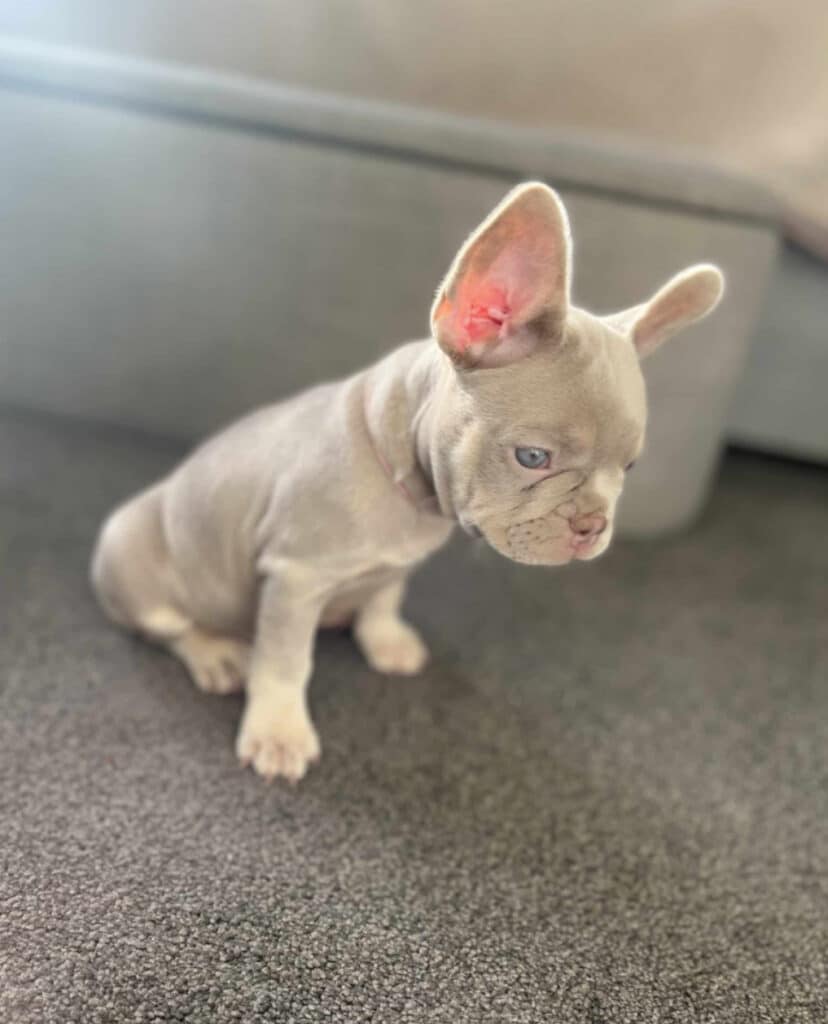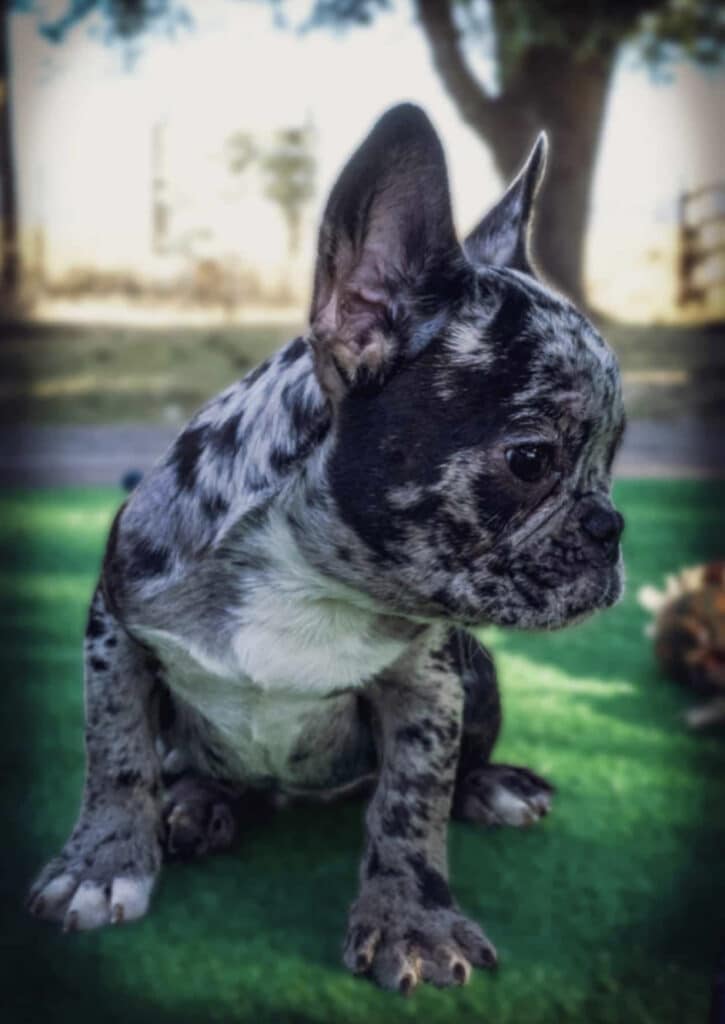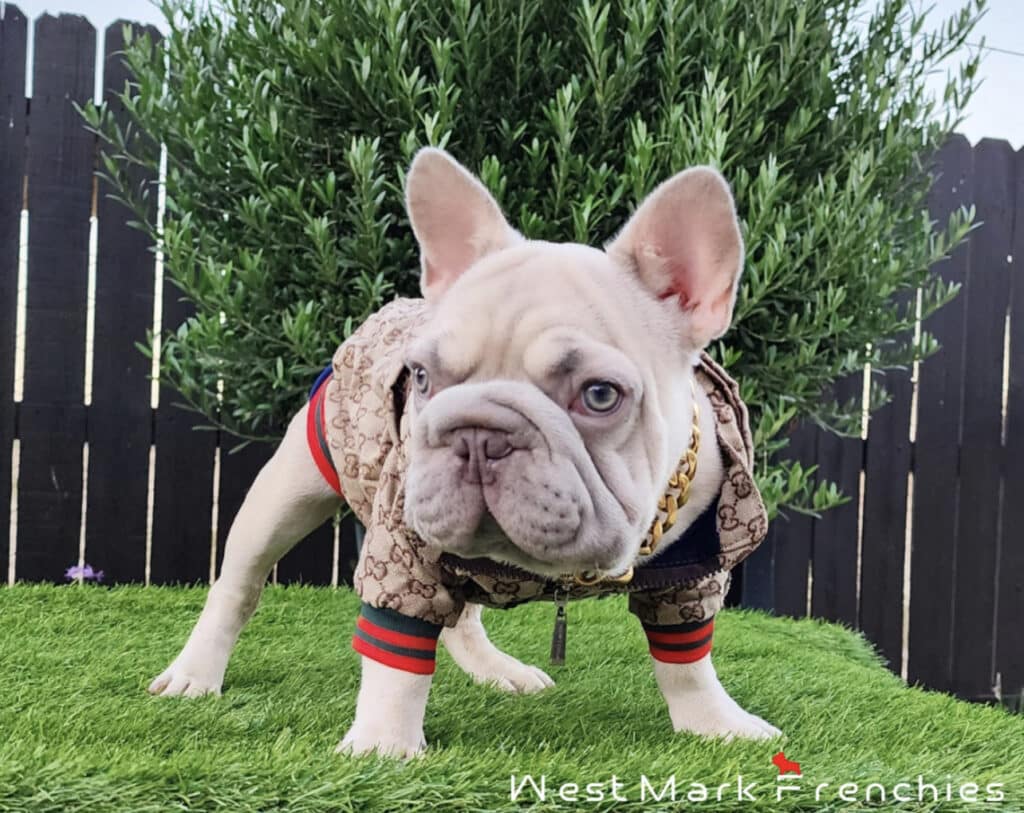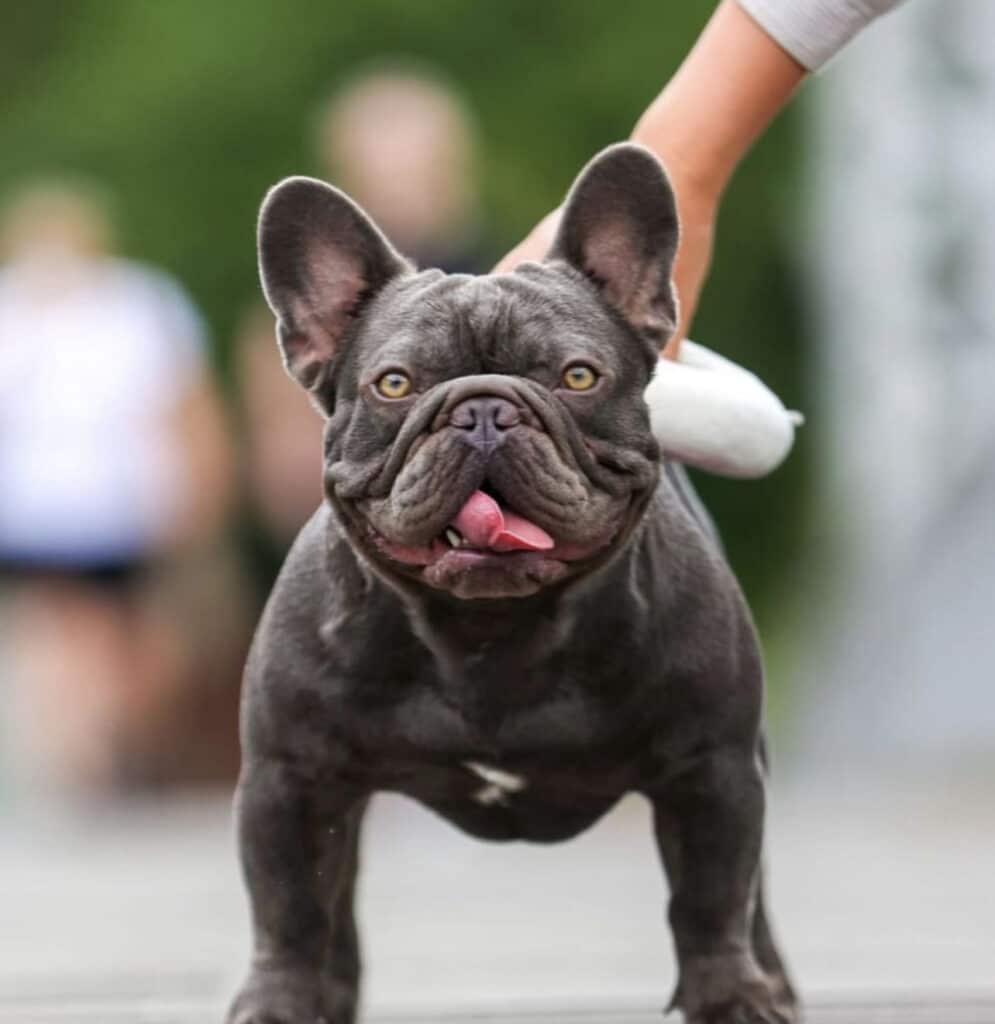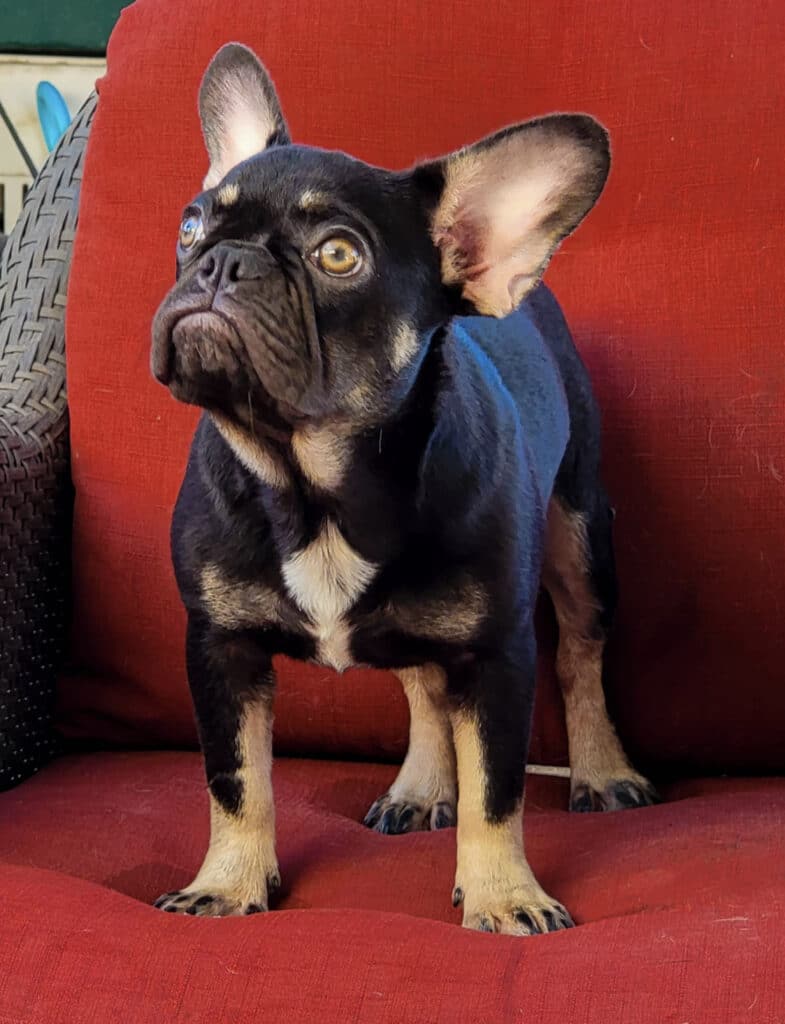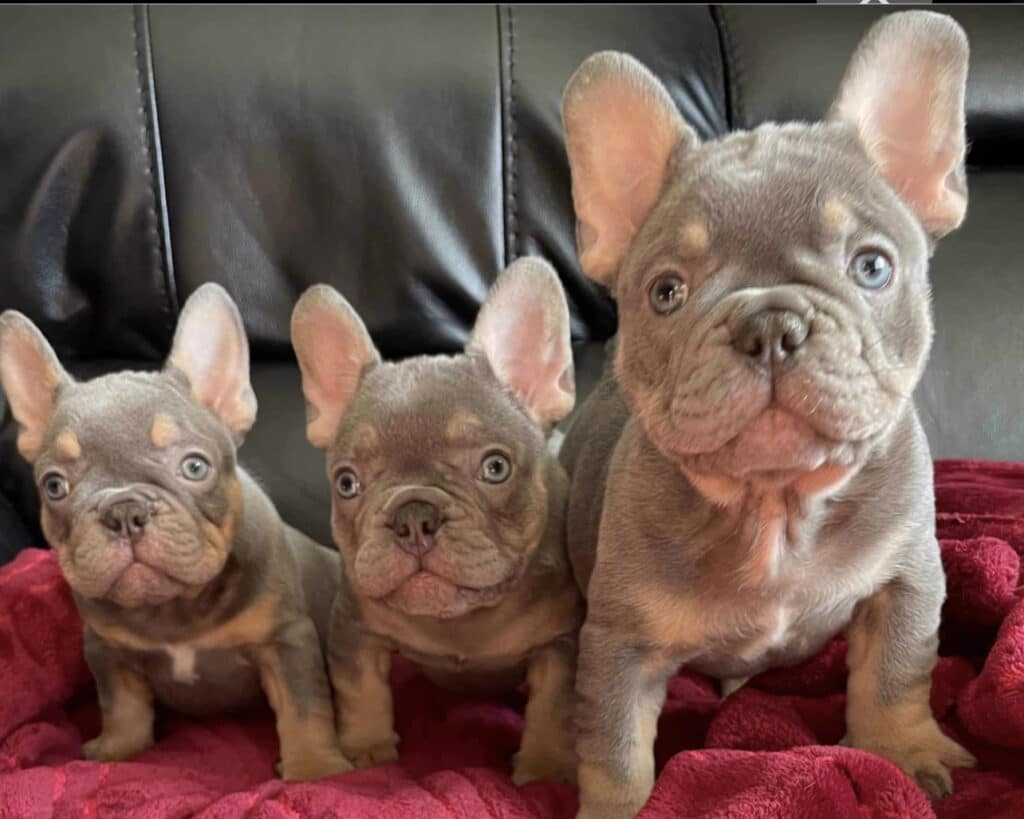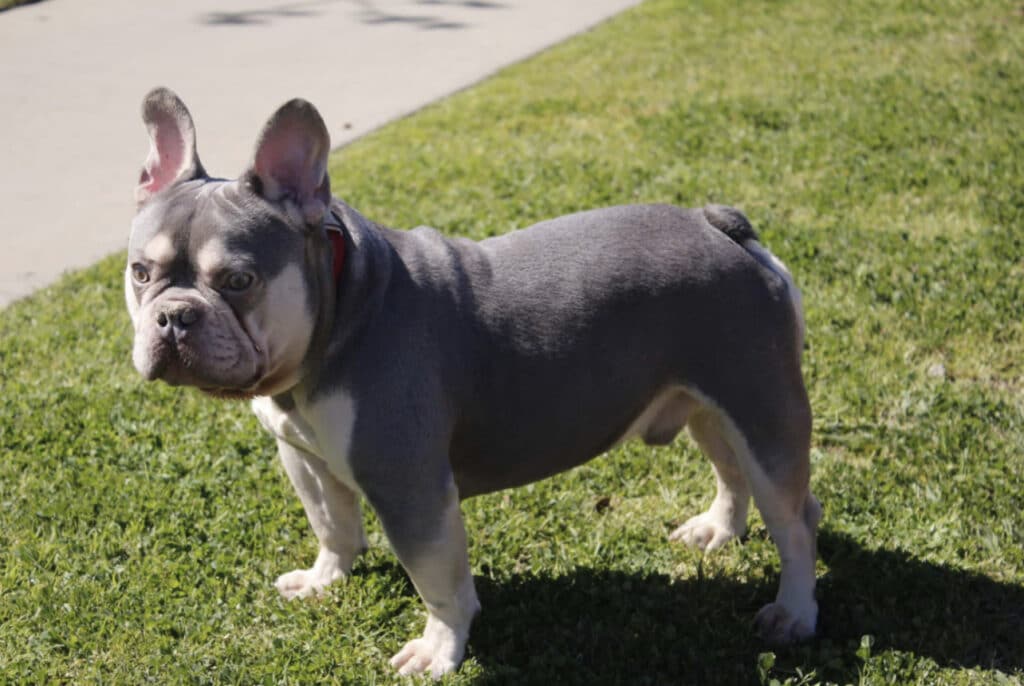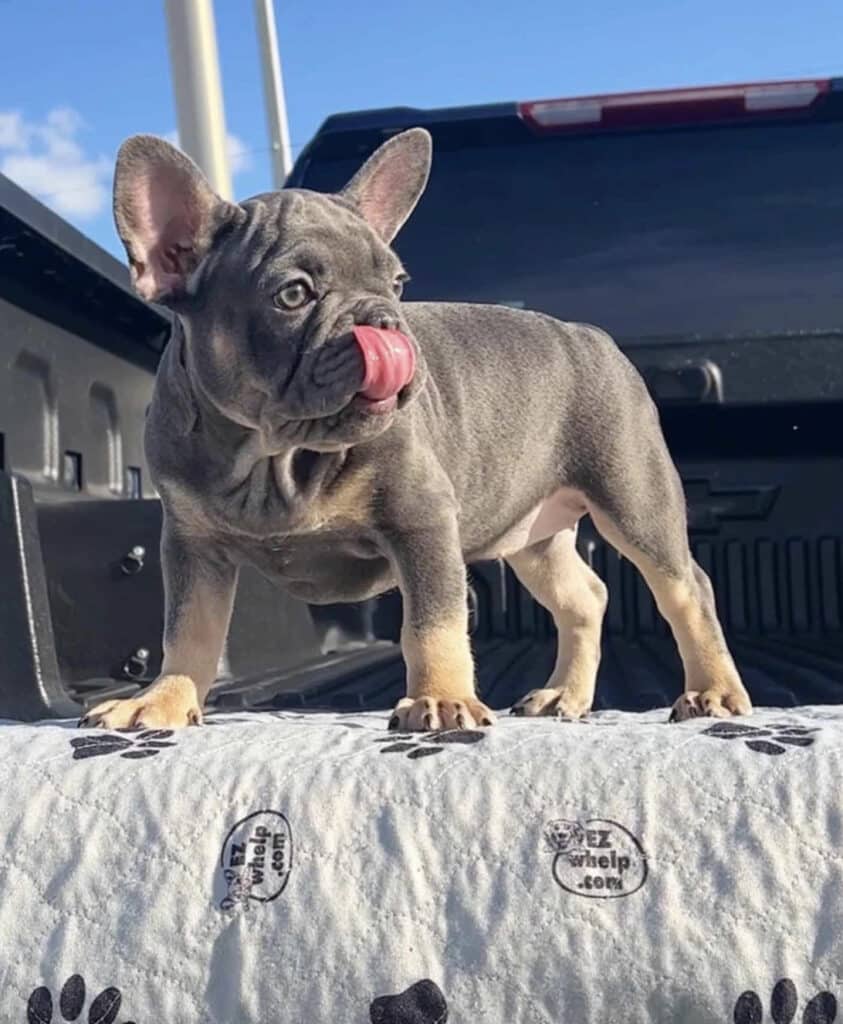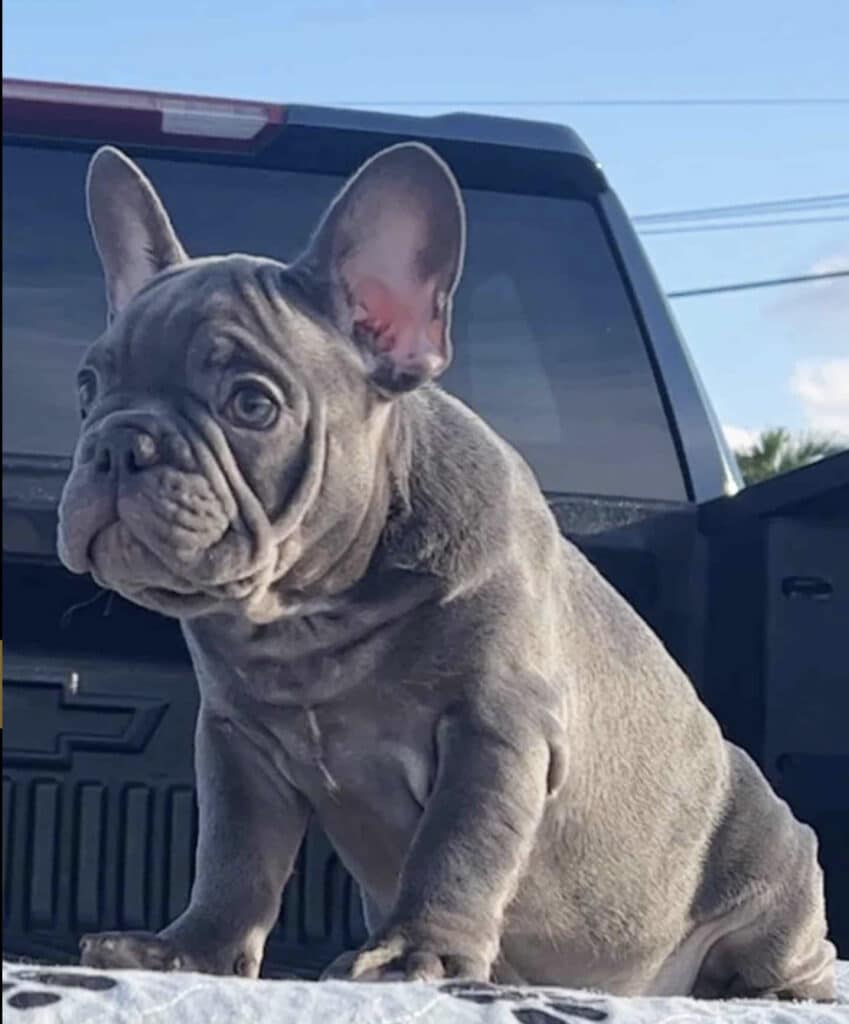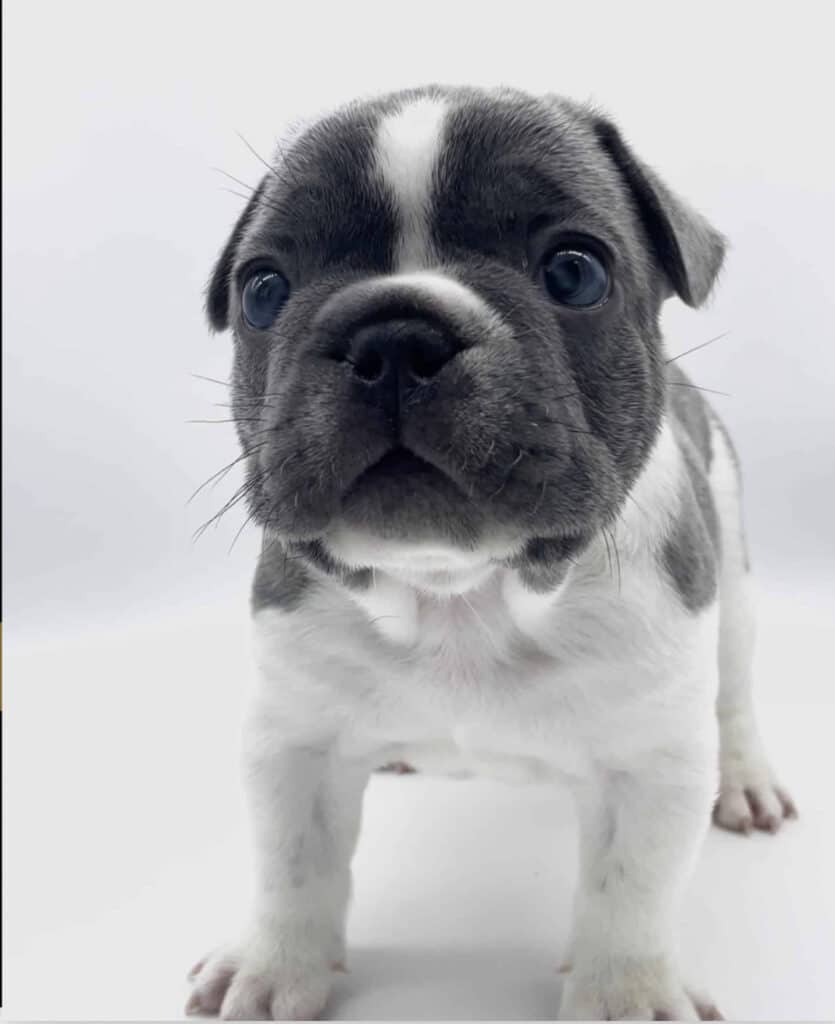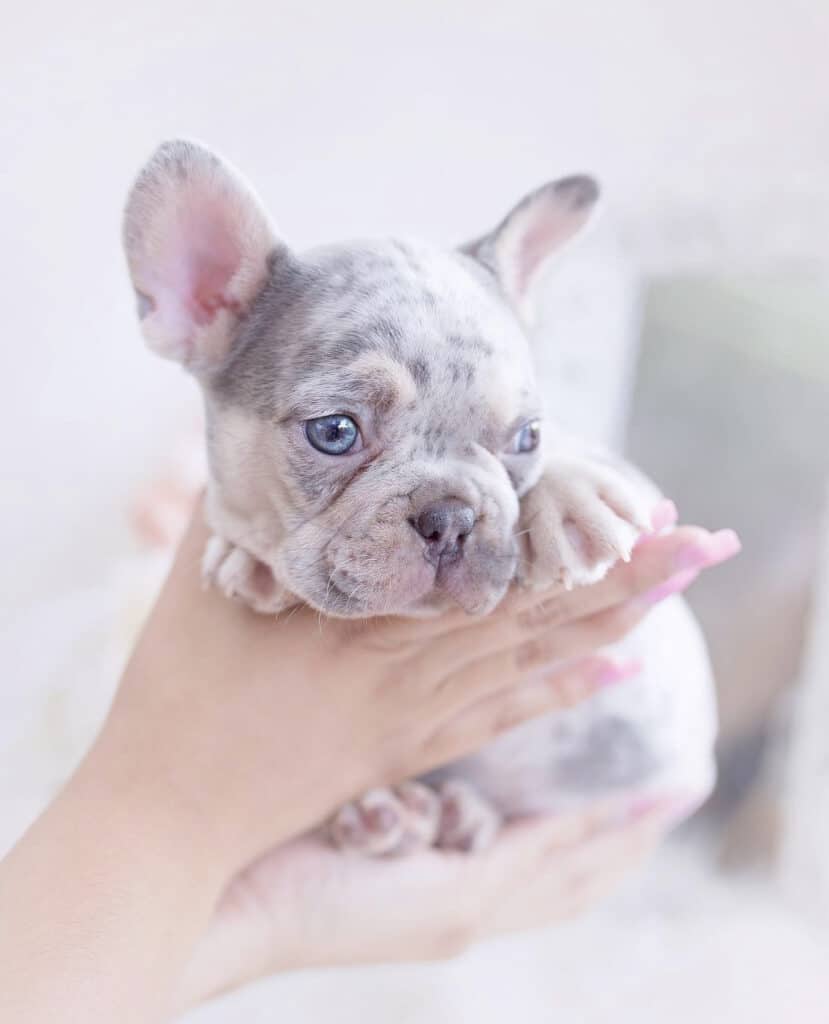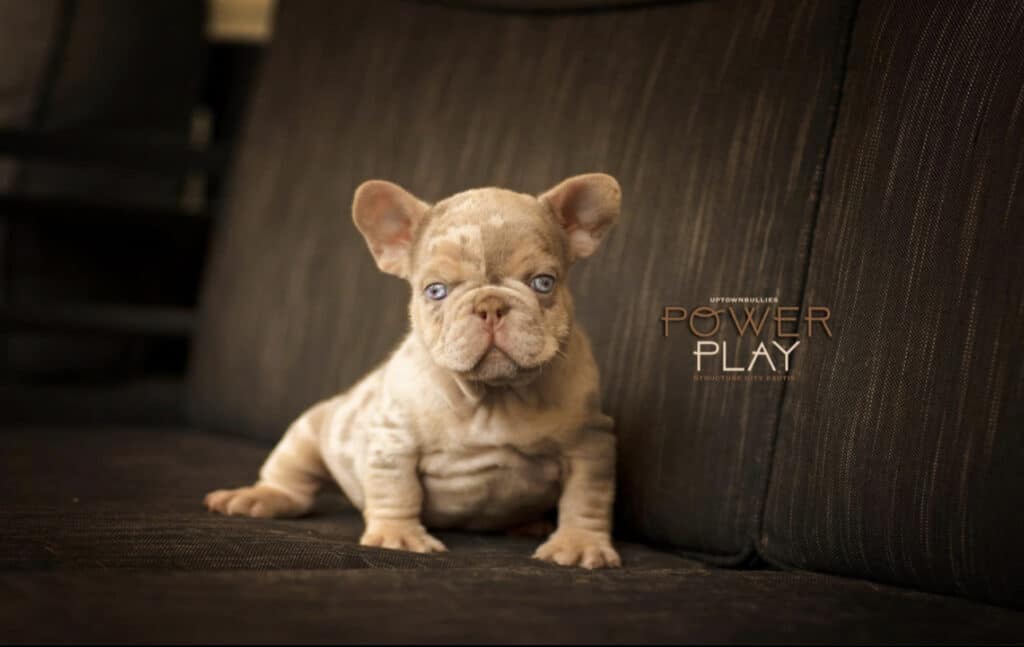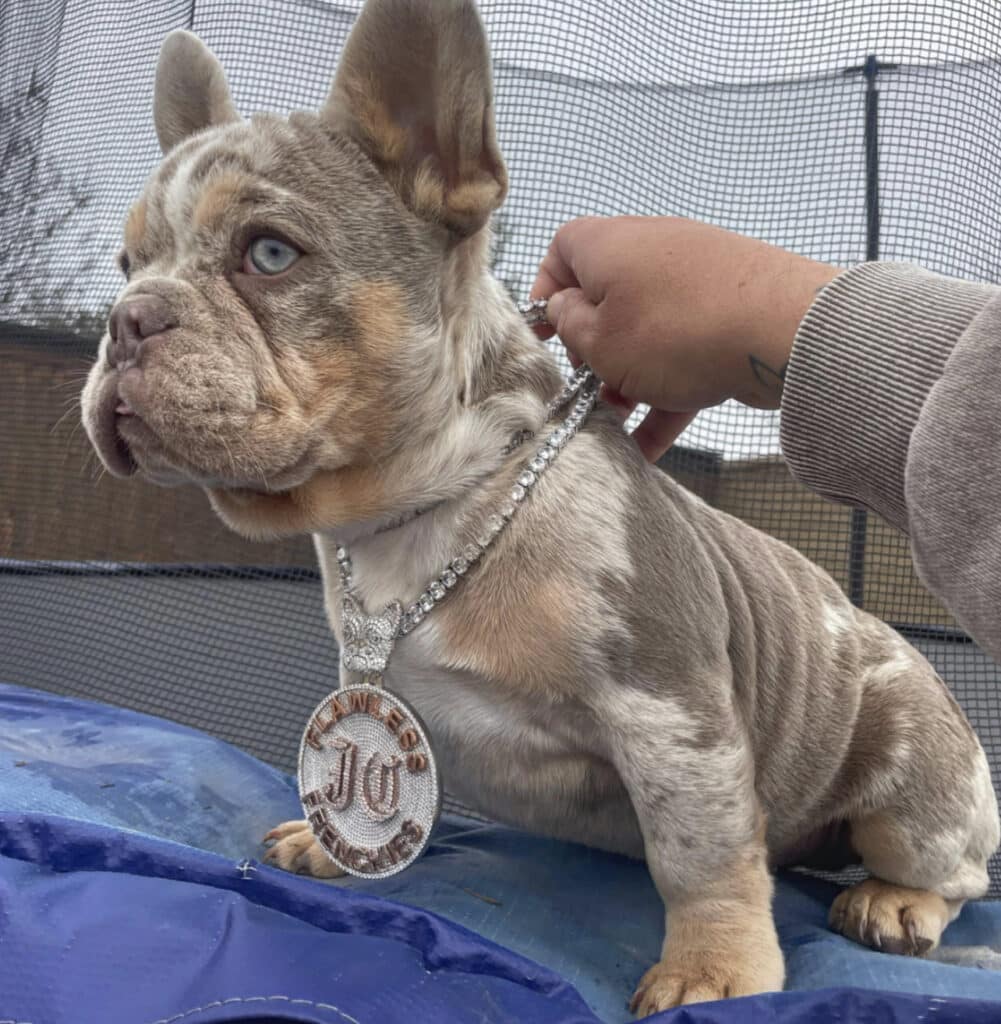
The French bulldog breed is full of intricacies. The coat colors across the breed spans a large spectrum. This variety is due to advances in DNA science and breeding experimentation.
Owning a rare colored Frenchie can be wonderful, but the uniqueness has led to an increase in their prices. This guide is the result first hand experience as well as specific research and interviews with other rare color and exotic Frenchie owners.
It is recommended that you first read the French Bulldog DNA guide to give you background for the following.
- Rare Color French Bulldog Images
- Frenchie Rare Color Chart
- 1. Blue French Bulldog
- 2. Chocolate French Bulldog
- 3. Lilac French Bulldogs
- 4. Isabella French Bulldog
- 5. New Shade Isabella French Bulldog
- 6. Platinum French Bulldog
- 7. Merle French Bulldog
- 8. French Bulldogs With Intensity – (i/i)
- Conclusion
Rare Color French Bulldog Images
Frenchie Rare Color Chart
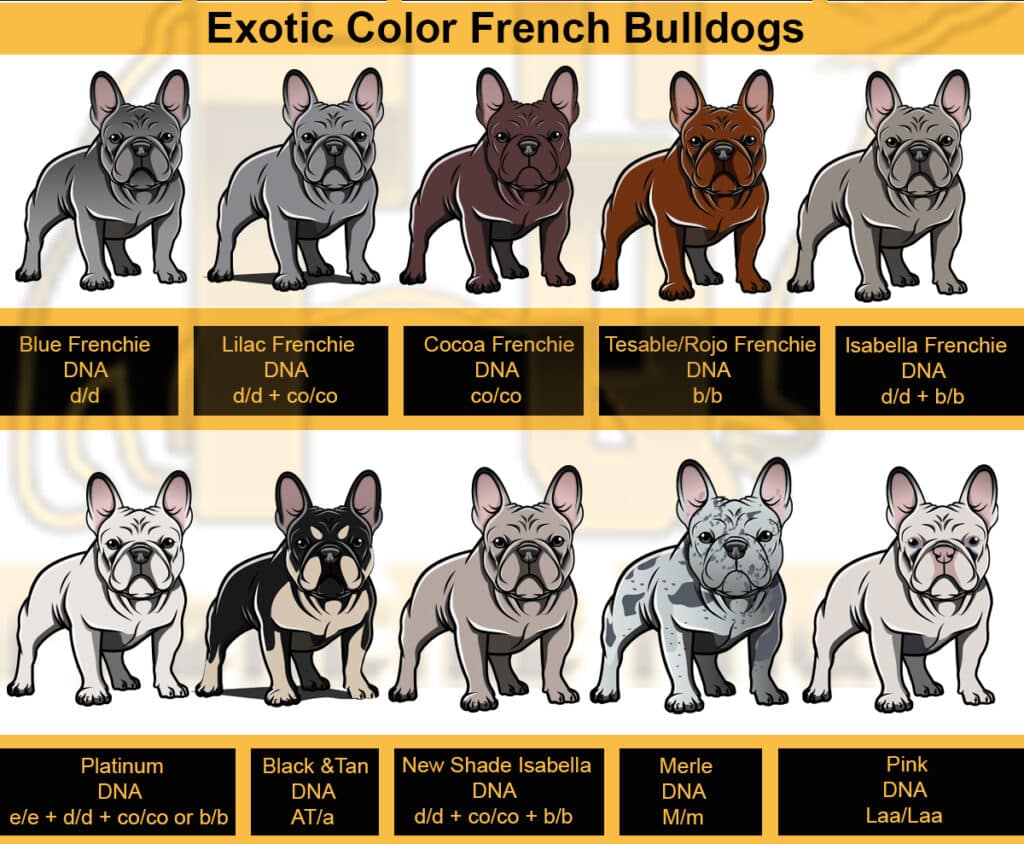
1. Blue French Bulldog

The Blue French Bulldogs often leave people speechless. Not only are they exotic but French Bulldogs were the 2nd most popular breed in the world in 2020 and 2021 according to the AKC. In 2023 they became the #1 most popular breed in the US.
What is a Blue French Bulldog? A true blue Frenchie tests positive for “dd” on a genetic test. A dilute color is indicated by a “d”. It is recessive, which means that a visibly blue dog requires two copies of “d.” If the dog were to indicate “Dd” on a genetic test, it is a carrier. If coupled with another dog with either dd or Dd, a blue carrier can produce blue offspring in some instances.
Frenchies with two copies of the d mutation at the D locus will have a genotype of d/d. As a result, the black and yellow/red pigments that produce the French Bulldog’s coat color are diluted or lightened. It will also change or dilute a dog’s base coat color, which is determined primarily by the E, K, A, and B genes.
This dog will pass on one copy of d to all of its descendants. If bred to a dog who is also a carrier of the d mutation (D/d or d/d), this dog can produce d/d offspring.
The remarkable fur color of French bulldogs can only be attributed to their DNA. There is a widespread belief that blue-colored Frenchies will have a slew of health problems. As a respected French bulldog breeder, I disagree with this perception. If a dog was correctly bred and its parents were both healthy, the puppy should also be healthy.
How Much Does A Blue French Bulldog Cost?
Because breeders need to conduct extensive searches for healthy Frenchies with diluted genes, the cost to produce Blue French Bulldogs can be high. In general, Frenchies are expensive because of their inability to carry out normal birth and the costs associated.
Typically a Blue French Bulldog costs around $4000 and goes up to $15000 depending on sex, pedigree, and hair length. Many owners feel these personable dogs are worth the price.
Different Color Variations In Blue French Bulldogs
Frenchies are so versatile in color that even the blue color itself comes in many variations.
Blue Fawn French Bulldog – (d/d) + (Ay/Ay) or (d/d) + (Ay/a)
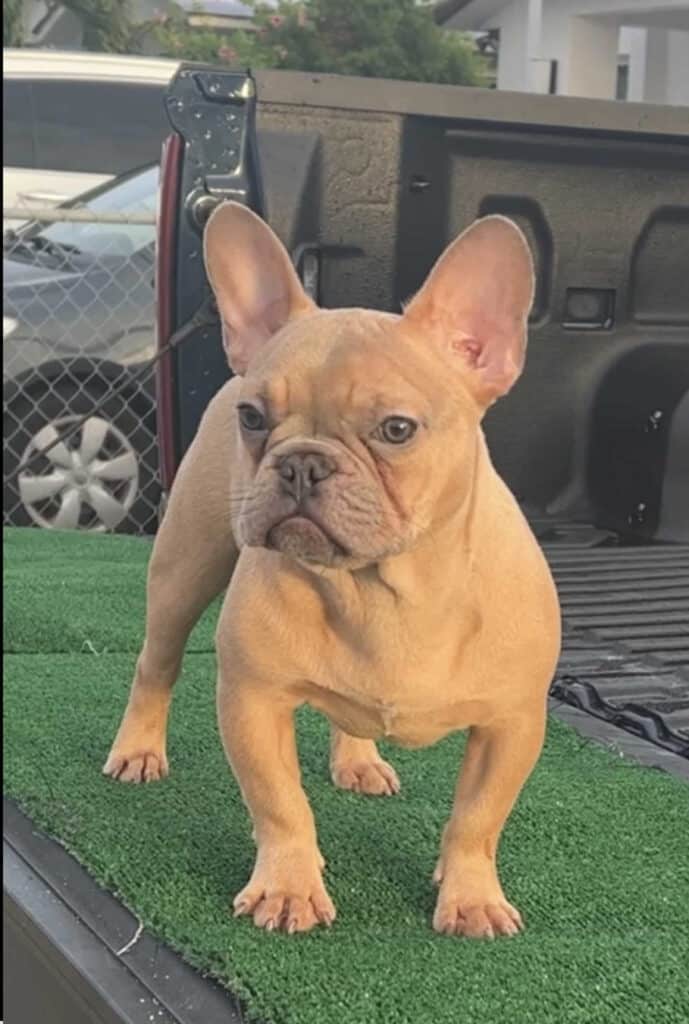
The Blue Fawn French Bulldog looks like a fawn but has the dilution gene. These Frenchies tend to have a dark appearance in their fur. They carry the gene for producing blue puppies, which means they have 2 (d) alleles at the D Locus.
In order to create this puppy both parents need to have carried the blue recessive gene. Blue Fawn French Bulldogs tend to have a more greyish blue than a French Fawn’s coat. Dilution is frequently visible on their masks, noses, ears, and paw pads.
They also have a slightly different distinguishing mask color than regular Fawn Frenchies. Blue Fawn is a French Bulldog color that combines light fawn and blue.
These puppies, in particular, have blue around their muzzle and eyes instead of black, and their light coat has a beautiful bluish shine. This rare French bulldog color, like blue, has become a favorite in recent years.
Blue Sable (d/d) + (Ay/At)
The Blue Sable Frenchie is one of the most popular sables. Blue Sables have a fawn color on the head and lower legs.
They don’t, however, have black-tipped body hairs or black masks. They have lovely blue-tipped hair with a blue mask instead. The
Blue Sable is a rarer variation of the Sable Frenchie. They are dilute blue carriers.
Blue Merle French Bulldogs – (M/m) + (d/d)
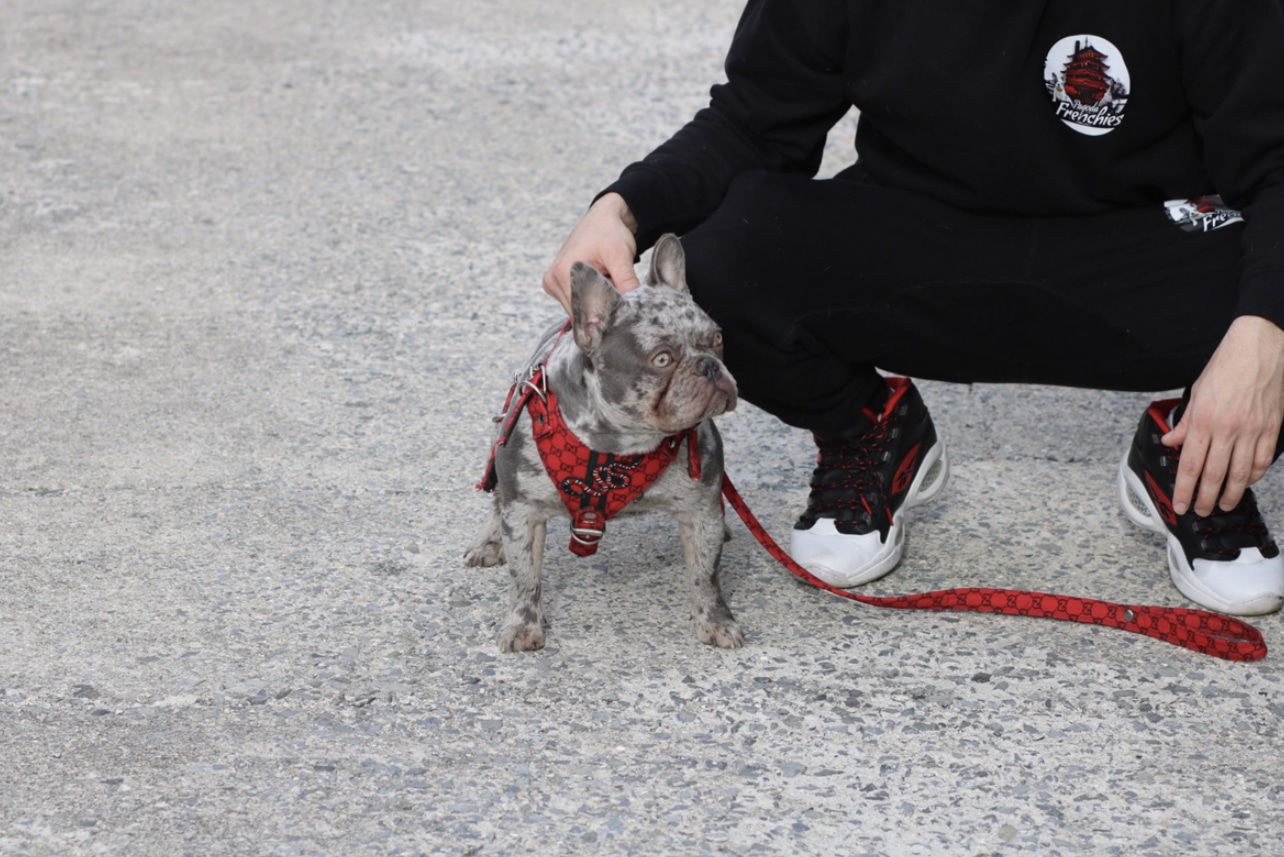
The Blue Merle French Bulldog has a peculiar appearance and is extremely difficult to breed. A breeder must choose a Blue French bulldog and a Merle Frenchie to produce this rare color Frenchie. In order to breed a Blue Merle Frenchie both parents must carry at least 1 copy of the dilute gene “Dd”. To guarantee a blue Merle French Bulldog you would need both parents to have 2 copies of the dilute gene “dd” and at least 1 parent being a Merle Frenchie “Mm”. The Merle is a dominant gene but can not be bred with another Merle French Bulldog, therefore, only 50% of a litter will be Merle.
Blue Brindle French Bulldog – (Kbr) + (d/d)
The Blue Brindle Frenchie has a blue/gray coat showing brindle flecks. Brindle striping appears on puppies around the age of four weeks. Their eyes can be yellow, brown, blue, or gray.
Blue Pied French Bulldog – (S/S) + (d/d)
The chest, legs, and cheeks of Blue Pied Frenchie puppies are usually light-colored or white. French bulldogs may have the pied pattern on one side of their faces or in different variations.
2. Chocolate French Bulldog
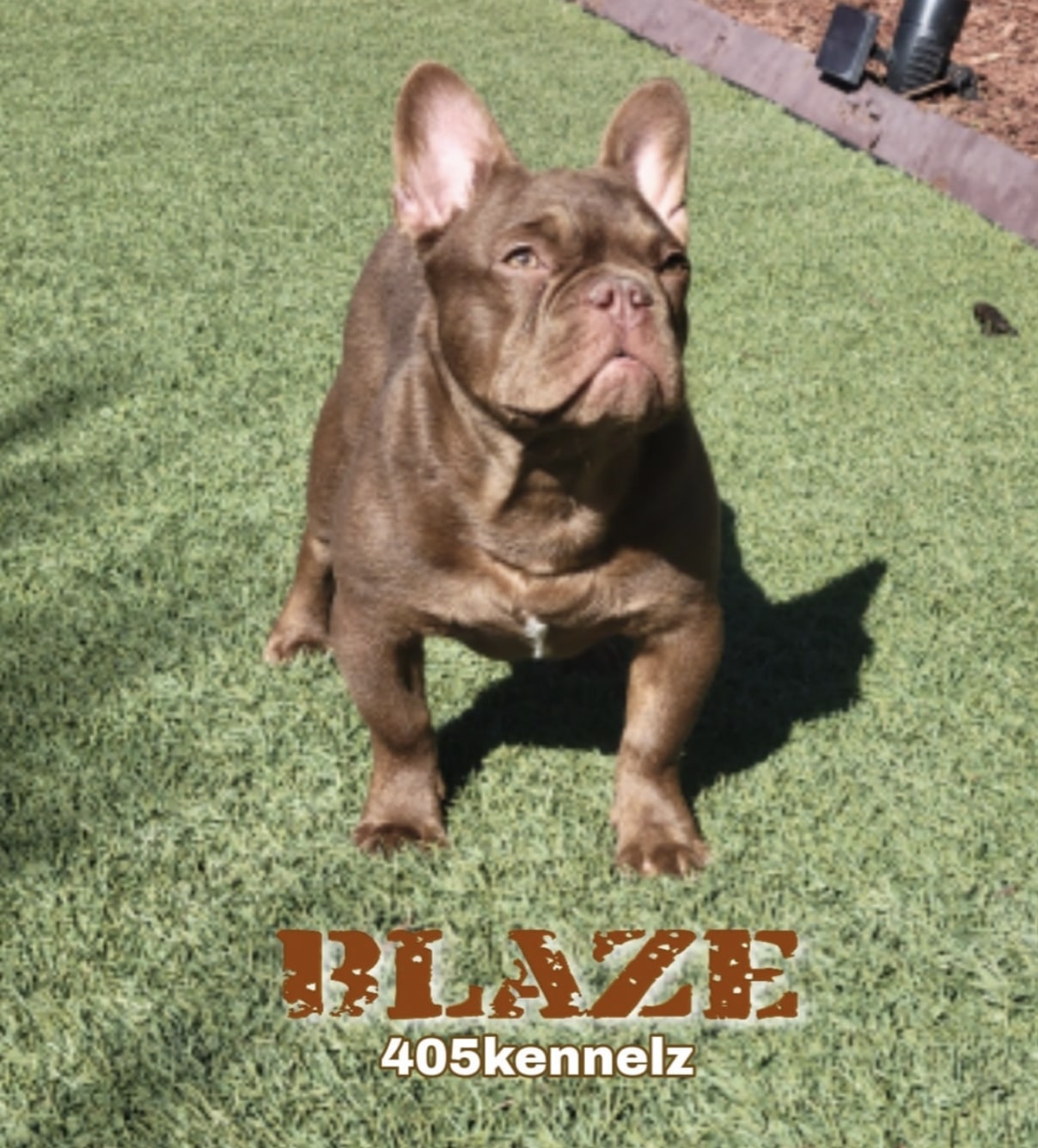
Not every brown-looking Frenchie can be classified as a Chocolate French Bulldog. A true Chocolate French Bulldog carries two ‘bb’ (testable chocolate) alleles in the B locus of the DNA. These dogs have light-colored eyes, with green, brown, golden, and even yellow eyes. They’re just like typical Frenchies in every other way.
What makes a Chocolate French Bulldog unique is the gene responsible for its chocolate fur. This gene is so rare that the AKC does not consider Chocolate as a standard color. This has prevented a lot of breeders from producing this particular colored breed.
Testable Chocolate French Bulldog vs. Non-Testable Chocolate French Bulldog
Testable Chocolate Frenchie | Rojo Chocolate French Bulldog Explained

To know whether a dog is a true Chocolate, you need a DNA test . If the B locus shows your French Bulldog carries the ‘bb’ genes, congratulations! You have a testable chocolate Frenchie.
The B locus (TYRP1) is a gene modifier that alters the production of eumelanin. This dilutes black pigment into brown pigment while leaving red pigment (pheomelanin) alone. The “b” allele is the mutated gene that converts black to brown.
A testable Chocolate dog has two copies of b at the bc, bd, or bs loci, giving this dog a B locus genotype of b/b. As a result, this dog will usually have a brown coat, nose, and foot pads. Although, this French has two testable chocolate copies, it has a lighter chocolate coat than the non-testable chocolate.
b/b dogs may be referred to as brown, chocolate, liver, or red, depending on the breed. However, the color of this French Bulldog’s coat is determined by the genotypes of numerous other genes. This Frenchie’s offspring will all inherit one copy of b.
If bred to a French Bulldog who is also a carrier of the b mutation (B/b or b/b), this dog can produce b/b offspring.
Non Testable Chocolate Frenchie | Cocoa French Bulldogs Explained
You can also test your Frenchie for the non-testable chocolate coco by employing this simple trick. Take your Frenchie into a dark room and shine a light from a distance into their eyes. Their eyes should blaze brilliant red. You have a non-testable Chocolate French Bulldog.
Non-testable French Bulldogs have a Co Locus genotype of co/co, two copies of the co (cocoa) mutation. As a result, this dog will typically have a cocoa-color coat, nose, and foot pads. Co/co dogs may be referred to as cocoa, brown, or chocolate, depending on the breed. However, the color of French Bulldog’s coat is determined by the genotypes of numerous other genes. This dog’s offspring will all inherit one copy of co. If bred to a dog who is also a carrier of co (CO/co or co/co), this dog can produce co/co (cocoa) offspring.
Health Issues in a Chocolate French Bulldog
Chocolate French Bulldogs are prone to some health problems. Unlike the other rare color brothers such as Blue or Merle, Chocolate Frenchies only have health issues comparable to what a regular standard colored French Bulldog might have.
- Brachycephalic issues: The Chocolate French Bulldog is a Brachycephalic dog breed, which means its head is short and its snout is flat. The unique skull shape causes the crowded and restricted respiratory route.
- Hip dysplasia: This is an issue that occurs when the Frenchie’s hip joint is not developed properly. It causes the leg bone to grind against the socket. This condition often leads to arthritis and loss of functionality.
Ways to Take Care of a Chocolate French Bulldog
Chocolate French Bulldogs are pretty sensitive, so they require a little extra care compared to others. Their additional care can include:
- Keep the skin folds clean because a moisturized skin fold can harbor bacteria leading to multiple infections. Always make sure to dry your Chocolatey buddy completely.
- Mounting and mating are difficult for Chocolate French Bulldogs. Males who are neutered are less likely to develop hunching habits or develop spinal problems. Females that have been spayed will not have undesired pregnancies, which helps to protect their health and extend their lives.
- It is best to use a dog harness whenever you are out for a walk to avoid straining the necks and throats of your dog.
3. Lilac French Bulldogs

The Lilac Frenchie, a product of their French Bulldog parents’ blue and chocolate DNA, is a unique Frenchie breed having 2 copies of blue gene mixed in with 2 copies of chocolate or cocoa gene. Due to this mix of blue and brown genes, Lilac Frenchies are known for their light eyes and pink muzzles. Their coat, which has lilac tones, is what sets them apart.
Lilac French Bulldog – (d/d) + (co/co)
Lilac French Bulldogs are one of the most elusive colors. One of the reasons they are so uncommon is that they must have both blue (d/d) and chocolate (co/co) genes. Both of these genes are extremely rare. When you find a dog with both, you’re looking at a one-of-a-kind specimen.
Lilac French Bulldogs are born black and then diluted twice by the Chocolate and Blue genes. The “coco” and “dd” dilute black to brown and blue, respectively.
The Lilac Frenchie coat should be shiny and similar to Weimaraner Grey in appearance, with many lighter and darker shades possible. Some lilac coats will have a green or pink undercoat that will shine through depending on the light the dog is in. The nose, eyeliner, and footpads are all purple/Lilac.
Why is a Lilac French Bulldog so Expensive?
Due to their rare color, there has been a shift in the demand for the Lilac French Bulldogs. However, what makes this particular breed more expensive is the personal efforts and investment required of the breeder.
The cost of a Lilac French bulldog ranges from $5,000 to $20,000 or more. A purebred Frenchie whose has been approved for breeding will will likely cost $5,000+. Similarly, expect to pay $7,000+ for a Lilac and Tan French bulldog and $9,000-$12,000+ for a Lilac Merle French Bulldog. The prices go up when considering a long haired Lilac French Bulldog.
One of the main reasons why the cost of a Lilac Bulldog is higher than that of other breeds is their inability to conceive naturally. Their triangular body shape prevents this. A growing number of breeders are turning to artificial insemination.
Furthermore, females have trouble giving birth to puppies due to their small hips. As a result, around 80% of French Bulldog puppies are delivered via cesarean section.
Lilac French Bulldog Care
Lilac Frenchies must wear appropriate dog footwear when walking on ice and icy streets in the winter. When it comes to paw and nose care, a Lilac Bulldog’s skin should always be moisturized and clean. Moreover, the extra focus should be on the pink skin around their mouth and nose.
Make olive oil and coconut oil regular treatments for paw protection. This concoction will form a protective layer on the paw pad of the dog. The French Bulldog has a thin coat and sensitive skin. Gloves are preferred since soft silicone pins won’t bother your skin. The silicone Frenchie brush glove is simple to use and will help you reach every part of your pet’s body and it cleans the soft area between the folds.
4. Isabella French Bulldog
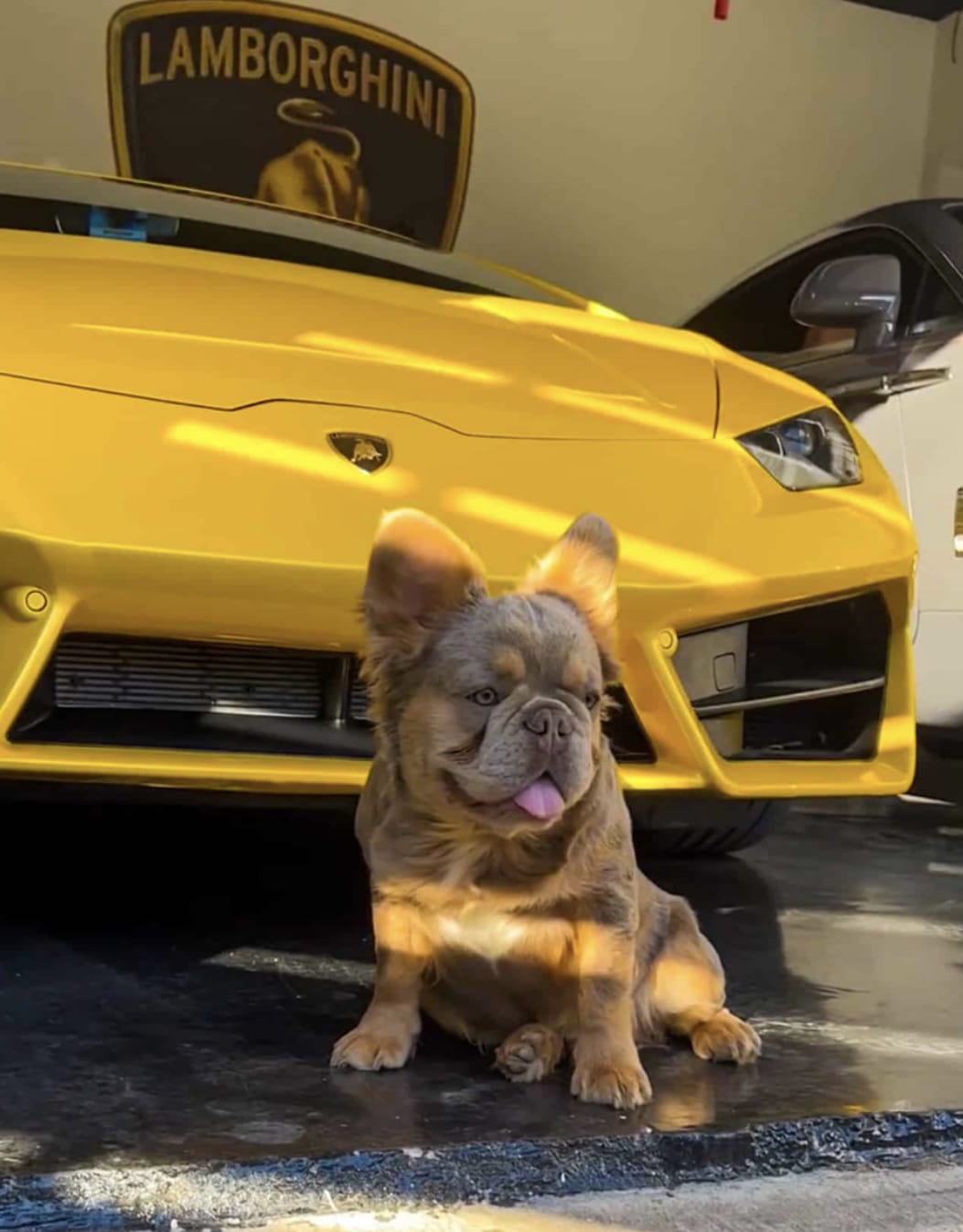
The Isabella French Bulldogs are one of the rarest French Bulldogs in terms of color. They have a liver/grayish-blue color due to numerous genes being diluted, including red, liver, and black. They have is a light blue and brown eye color.
The Isabella French bulldog’s DNA and genealogy makes them rare and unique. Their recessive gene is diluted.
Isabella French Bulldog– (d/d) + (b/b)
The Isabella French Bulldog has a distinct color from the Lilac. Even though they both require two chocolate genes and two dilution genes, these chocolate alleles live on different Loci. The Isabella Frenchie has 2 copies of Rojo Chocolate aka Testable Chocolate (b/b) + 2 copies of blue (d/d).
This color looks different than Lilacs because the chocolate is testable and that the breeder tested the French Bulldog’s DNA to ensure that it carried the chocolate/Rojo gene. The only way to be certain that the dog is an Isabella Frenchie is to do this. You can’t just look at a dog and say it resembles Isabella. It must be tested and verified.
These are currently the one of most difficult French Bulldogs to find. You must go to a breeder who specializes in this coloration and then be prepared for a long waiting list. Because of their increasing popularity, they may become less scarce in the future.
What Does an Isabella Frenchie Look Like?

Isabella Frenchies have square heads with flat facial features, including the nose, mouth, and eyes, and darker color shades surrounding their eyes and mouth. Their noses are typically dark in color, matching their fur. However, they have pink skin around their eyes, nose, and mouth. The bat ears are an intriguing physical feature of the Isabella French bulldog.
The Isabella French Bulldog Grooming Guide
The Isabella French Bulldogs are pretty low maintenance compared to other breeds.
Start by brushing out any obvious dirt on the Isabella French bulldog before bathing.
These beloved canines should then be bathed in a modest amount of warm, not hot, water. The dog doesn’t have to be completely submerged in the tub; a modest amount of water rising no more than halfway between their legs and tummy suffices. The mouth, eyes, ears, and nose should be wiped using gentle non fragrant wipes.
Dry your dog completely, especially the face. since they have folds that can retain moisture leading to infections.
5. New Shade Isabella French Bulldog
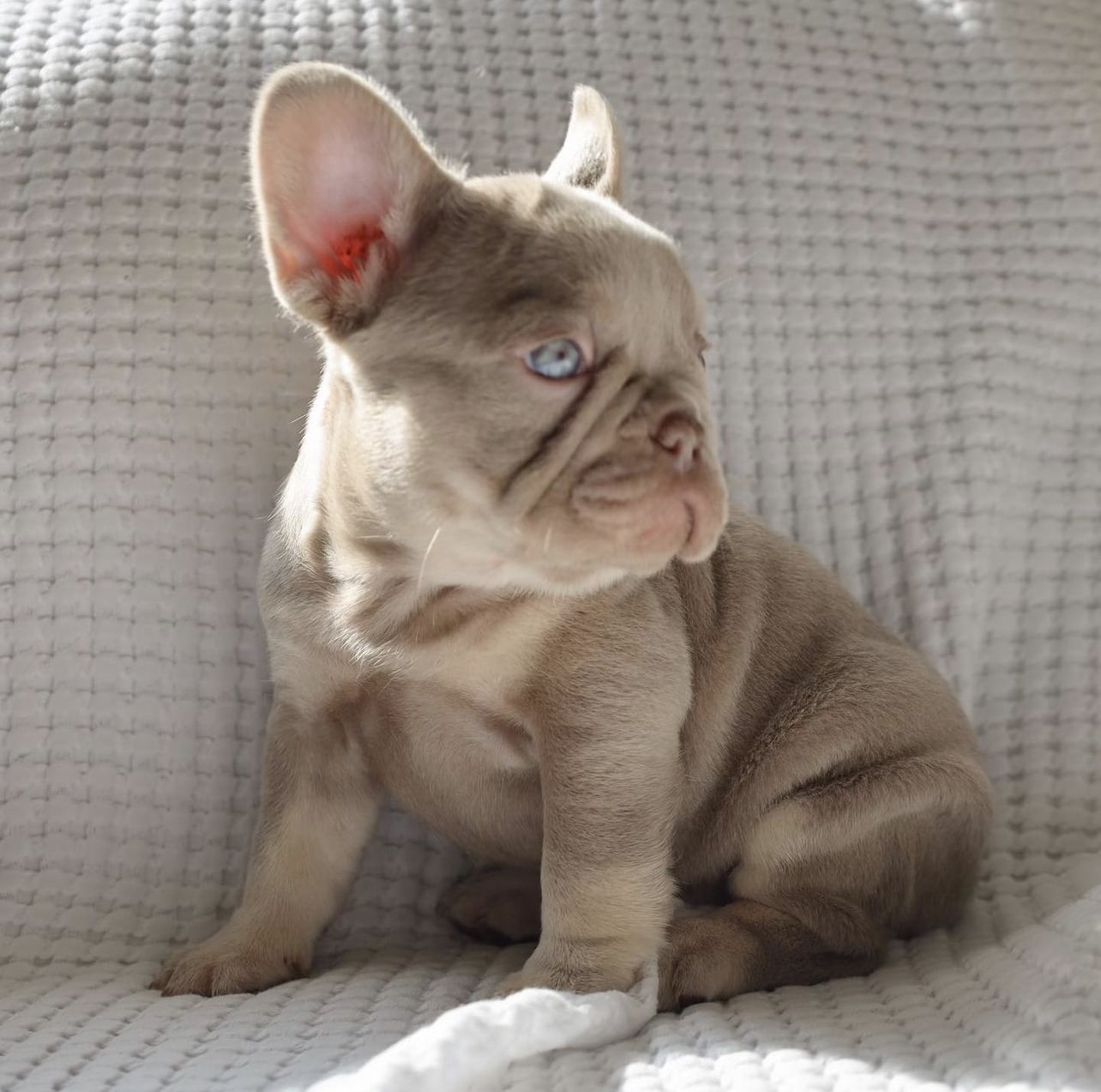
The New Shade Isabella French Bulldog carries copies of both the testable and non-testable chocolate genes ‘bb coco.’
A New Shade Isabella has the same genetic makeup as a New Shade Frenchie, but with the two extra copies of blue. Thier DNA markers are ‘dd + coco + bb’. A New Shade Isabella that carries two copies of Intensity is sometimes referred to as a “New New Shade.” It is a ‘dd + coco + bb’ dog with two copies of intensity, which is ‘ii’. The intensity gene is a color modifier gene. As the name suggests, intensity gives its underlying color partners a more intense or crimson color.
New Shade Isabella French Bulldog – (d/d) + (b/b) + (co/co)
With the DNA marker being a d/d b/b co/co sequence the resulting color is a pale gold-tinged pink.
AKC Does Not Accept New Shade Isabella
Breed standards are fairly stringent at the AKC. Some standards haven’t been altered much since the 1980s. While “New Shade Isabella” isn’t specifically mentioned, the AKC states that “all other colors, markings, or patterns are a disqualification.”
Blue-eyed Frenchies are likewise disqualified. On occasion, New Shade Isabella French Bulldogs may have light brown eyes, but their coat would still exclude them.
How Expensive Are the New Shade Isabella French Bulldogs Are?
On average, this rare color costs about $9000 – $15,000. A visual fluffy New Shade Isabella can go for $50k+.
6. Platinum French Bulldog

Platinum technically is not a color but rather the absence of color. Platinum can be evidenced on a genetically “True Color Dog”, such as a Dark Chocolate Tri with all-white fur, for example.
Looking at their nose, eyes, lips, and paw pads, you can notice evidence of dilution in a French Bulldog with a Platinum finish. The Platinum French Bulldog will have a diluted version of the black nose, dark eyes, and black paw pads found on a regular cream French Bulldog. Platinum Frenchies will be either genotype ‘dd + coco + ee’ or ‘dd + bb + ee.’
Platinum French Bulldog – (e/e) + (d/d) + (co/co) or e/e) + (d/d) + (b/b)
Platinum is a cream-covered Lilac French Bulldog “dd coco” or a cream-covered Isabella French Bulldog “dd bb.” Its DNA will be either “dd coco ee” or “dd bb ee.” The cream can cover other colors as well. Platinum is always Lilac or Isabella with cream on top.
A Platinum Frenchie is a cream-colored bulldog with dilution marks around its eyes, lips, and paw pads. The Platinum Frenchie is very similar to the Albino, but they have luster on their coat, and, unlike the all-white Albino, they can have different colors other than their diluted face.
Platinum French Bulldogs are typically a hit with both kids and adults in the family!
Cream vs. Platinum French Bulldog
The Cream French Bulldog is often mistaken for Platinum Frenchies.
A genuine cream-colored French bulldog is slightly dull. It is somewhat off-white while being a solid color. The solid cream hue becomes more noticeable as the puppies mature, with subtle cream borders to the ears. Unlike Pied or Fawn Bulldogs, French Bulldogs do not acquire strong color patterns on their bodies.
As a result, true cream is a rare color in French bulldogs, and it differs significantly from Platinum. With that being said, a Platinum French bulldog has a pink eye rim, whereas a cream French bulldog lacks pink pigment and certain hues of a Platinum Frenchie.
7. Merle French Bulldog

Merle is a hereditary French Bulldog coat pattern that dilutes the coat’s random areas to a lighter color while leaving patches of the original color. It gets this condition when a French Bulldog has the “M” Merle allele and a negative “m” copy of the Merle allele. ‘M/m’ is a Merle Frenchie.
A mottled patterned coat, impaired skin pigmentation on the nose and paws, and blue or odd-colored eyes distinguish the French Bulldog. Blue merle and red merle are the two primary colors of the Merle coat. The Merle gene affects the dark pigment in the eyes of French Bulldogs, turning them partially or wholly blue or odd-colored. In addition, the Merle gene causes pale pink paws and noses in French Bulldogs, increasing the popularity of the breed.
Merle French Bulldog – (M/m)
Merle is one of the most contentious French Bulldog coat colors. This color’s genetic code had to be introduced somewhere into the genetic line. Most Merle French Bulldogs are thought to have Chihuahuas in their ancestry.
Merle is a coat pattern in which the coat color is broken into splotches. It is a deletion gene, which means it randomly removes pigment from the coat. Merle is a spectrum disorder. Some dogs’ coats have only small cracks, while others’ coats have been deleted so much that only small dots of the original coat color remain.
These dogs are prone to a wide range of eye issues. Hearing loss is also common. While dogs only require one Merle gene to be classified as Merle, two Merle genes classify them as “extra” Merle. This double gene rarely affects their coloration. It will, however, make them more vulnerable to health issues.
Merle is also a dominant gene, meaning it only takes one copy to produce this coat pattern. Breeding a Merle dog to another Merle dog is not recommended due to health concerns in the offspring.
Common Health Problems
The Merle French Bulldogs are prone to many health problems due to their M allele. Here is a list of health issues that your Merle Frenchie can face.
- Hearing Impairment
- Vision Impairment
- Skin Cancer
- Microphthalmia is a rare condition that often causes tiny eyeballs along with non-functionality.
8. French Bulldogs With Intensity – (i/i)
This French Bulldog has two copies of the I mutation on the I locus genotype of i/i, resulting in extreme lightening of the light, pheomelanin pigments that produce the Frenchie’s coat. This dog will pass on one copy of I to all of its descendants. If bred to another dog who also carries an I mutation (I/i or i/i), this dog can produce i/i offspring.
Conclusion
I hope this rare color guide has been helpful!
